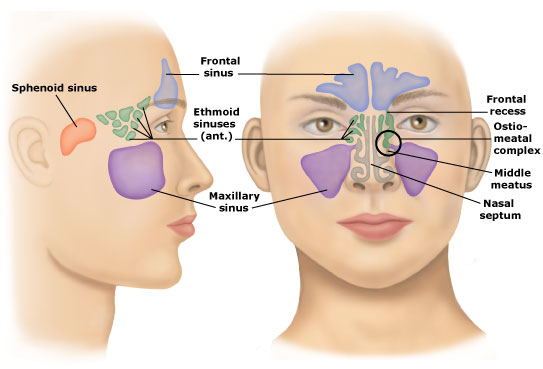Each year as fall season comes upon us, we are shut indoors and infections begin. For those of you who suffer with chronic sinus infections, this can mean fear and dread.
What is sinusitis?
Sinusitis is basically an inflammation of the sinus passages which include the maxillary, frontal, ethmoid, and sphenoid sinuses. This inflammation occurs often from the presence of bacteria, a virus, or even a fungus that our body is attempting to eliminate, but can also occur in the presence of things in our environment to which we may be allergic like mold, pollen, or dust.

The sinuses will typically fill with mucous and fluid, our body’s natural immune response, creating heat, inflammation and pain. A great deal of pressure in the head can occur, and can lead to headaches and even the aching of the upper teeth if the maxillary sinuses in the front of the face are overly filled with fluid.
Bacterial, Viral, Fungal?
It is quite difficult to determine if sinusitis is just inflammation due to a little bit of dust in your bedroom, or if there is an infection within the sinuses, unless you are tested. However, infection-based sinusitis can often have an associated cough, fever, persistent headache that worsens over several days, bad breath, and a smell from the mucous in your nose (rare, but unpleasant).
Bacterial sinus infections will respond quickly to antibiotics, but viral and fungal infections will obviously not. As a naturopathic doctor, many of the treatments that we use are multifaceted as in that a bacterial or fungal infection would be treated in much the same ways with similar antimicrobial herbs. Many of my patients who suffer with chronic sinus infections rarely have ongoing bacterial infections but mostly chronic inflammation that needs to be addressed in other ways. Simply killing offending microorganisms in these instances would not be adequate, as long-term relief also includes prevention.
Strategies to relieve sinusitis
- Move fluid
The main drag with sinusitis is that the tissues are inflamed and swollen, and there is a lot of mucous and fluid that just isn’t moving.
The NetiPot
Sinus rinses are fabulous at getting the sinuses going, and namely, the NetiPot, which works with gravity rinsing out both sides of your nose. I prefer the NetiPot to a sinus rinse because the sinus rinse requires your to simply shoot water directly up your nose, whereas the NetiPot is a little teapot that you tip into your nostril (as your head is tilted to one side) where warm salt water rinses through your sinuses. Moving from side-to-side creates less overall pressure in tight sinus passages, but also gives the ethmoid sinus an attempt to drain too (see the diagram above for a peek at those deep sinus cavities). Yes, it can be a little messy, but have a tissue box beside you and after a few rinses, you’ll see the beauty of this tool.
Acupuncture

Acupuncture Points for Sinus Drainage My favourite points to drain the sinuses are LI 20 and UB 2, right in the front of the face. Within minutes of acupuncture needles in the face, the sinuses start to drain and a great deal of relief (with the need to blow the nose) occurs!
- Reduce inflammation
To reduce inflammation, I like to take a two-fold approach:
Put things in the body to reduce inflammation, and take things out of the body to reduce inflammation. Seems simple enough, right?
Put in your body
Nettle and Eyebright are two fabulous anti-inflammatory herbs that are fabulous at not only reducing inflammation by reducing histamine in the body (histamine is what allows tissues to become hot, fill with fluid etc), but they reduce fluid congestion as they encourage fluid movement out of the tissues. I also like to have people increasing their fish oils!
Take out of the body
If you’re a singer, the first thing you learn is that cheese and dairy are the “enemy” to your vocal cords and your sinuses for a performance. Mucous-producing, these foods are going to increase inflammation during an episode of sinusitis. The same rules also apply to inflammation or histamine-releasing foods like wheat, tomatoes, bananas, pineapple, papayas, and vinegar-based foods (preserved olives, anchovies, capers etc). Reducing histamine-based foods in your diet for a few days prevents the body from making more histamine, which for inflammation, is like putting gas into a blazing fire.
- Kill microbes that don’t belong
If you do have an infection, there are a number of revolting herbs and vitamins that I like to use to support infection elimination; vitamin C and zinc are both anti-microbial. Herbal supports include the sock-tasting goldenseal (that can also be added in a few drops to the NetiPot to swish through the sinuses with your nasal rinse) and the shudder-inducing myrrh that while you may weep taking them, they really do work.
The role of natural therapies for sinusitis should not be overlooked; there are some great tools that can really lessen the experience of sinusitis and are also truly preventative. Happy November!